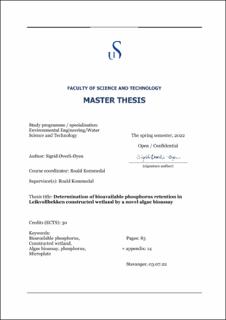| dc.description.abstract | Excessive phosphorus loads from agricultural runoff contribute to freshwater eutrophication, which leads to reduced water quality and changes across all trophic levels. Constructed wetlands, specially designed to retain nutrients and particles inputs through biological, chemical and physical processes, are used worldwide to treat anthropogenic discharges. The main objective of this study was to investigate the retention of bioavailable phosphorus in Leikvollbekken constructed wetland. Leikvollbekken is located on the southwestern coast of Norway and receives nutrient rich runoff from agricultural activities. Microplate reader was used to determine bioavailable phosphorus in water samples taken from the inlet and the outlet of the constructed wetland. Water samples were simultaneously chemically analysed to determine the chemical fractions and measured for total suspended solids. Microplate reader method can determine algae growth by measuring the change of fluorescence intensity over time. Two parallel bioassays were conducted. The first bioassay was performed with inoculum from Lake Store Stokkavannet, the recipient of the constructed wetland. The parallel bioassay was conducted with a pre-grown lake water sample. Due to methodological challenges, the analysis of bioavailable phosphorus was limited to three of total ten bioassays conducted, both for pre-grown and lake water inoculum. Results from bioassays performed with pre-grown inoculum showed that the constructed wetland on average retained 34 % of the incoming bioavailable phosphorus. Phosphorus analysis conducted on the corresponding water samples showed an average retention of 1 ± 4 % (phosphate) and 34 ± 2 % (total phosphorus). Bioassays performed with lake water inoculum demonstrated an average retention of bioavailable phosphorus of 24 %. Phosphorus analysis conducted on the corresponding water samples showed an average retention of 14 ± 3 % (phosphate) and 26 ± 2 % (total phosphorus). Regression analysis indicated a moderate to strong positive relationship between chemical available and bioavailable phosphorus. The calibration of the microplate reader, using flow cytometry and direct counting, indicated a strong positive correlation between fluorescence signal and algae cell concentration (R2 = 0.9986 for flow cytometry, R2 = 0.9995 for direct counting). A t-test (95 % confidence level) confirmed no significant difference between the two quantification methods. Results from the statistical analysis indicated that algae cell concentration in water samples can be determined by microplate measurement. However, the study revealed that the bioassay method probably was not optimally designed for determination of bioavailable phosphorus. Analysis showed that CO2 limitation had a substantial effect on algae growth potential. Bioassay supplied with CO2 showed approximately 55 % (pre-grown inoculum) and 40 % (lake water inoculum) more cells compared with bioassay not supplied with CO2. When determining bioavailable phosphorus, phosphorus must be the only limiting factor. In future studies using this method, the suggested improvements should be considered. | |
